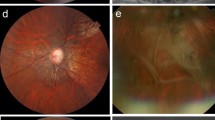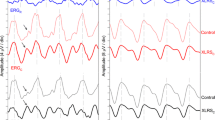Abstract
Simultaneous foveal and parafoveal electroretinograms (ERG) in response to two identical checks (6 degrees per side) alternating at constant mean luminance were recorded in 26 patients (52 eyes) affected by central hereditary chorioretinal diseases and in 14 age-matched normal subjects (14 eyes). Patients were divided into four groups according to clinical diagnoses: 1. Stargardt's disease; 2. cone dystrophy; 3. vitelliform degeneration; 4. pattern dystrophy. The amplitude and latency of the foveal ERG and the amplitude ratio between foveal and parafoveal ERG (F∶PF ratio) were measured. The mean foveal ERG amplitude was significantly lower than the control mean in all patient groups. The foveal ERG latency showed a trend to a increase in all pathological groups. However, this difference was not statistically significant. The mean value of F∶PF ratio was significantly reduced as compared with the control mean in Stargardt's disease and cone dystrophy only. In 46 of 52 affected eyes (88.5%) at least one of the electrophysiological parameters was abnormal. Our results suggest that the simultaneous foveal and parafoveal ERG recording may be a sensitive technique in hereditary degenerations of the central retina. This method may also contribute to a better understanding of cone degeneration pathophysiology.
Similar content being viewed by others
References
Brindley, G.S., Westheimer G. The spatial properties of the human electroretinogram. J. Physiol. 1965; 179: 518–537.
Biersdorf, W.R. Temporal factors in the foveal ERG. Curr. Eye Res. 1982; 1: 717–722.
Horiguchi, M., Miyake, Y., Yagasaki, K. Local macular ERG in patients with Best's disease. Doc. Ophthalmol. 1986; 63; 4: 325–331.
Seiple, W.H., Siegel, I.M., Carr, R.E., Mayron, C. Evaluating macular function using the focal ERG. Invest. Ophthalmol. Vis. Sci. 1986; 27: 1123–1130.
Bagolini, B., Porciatti, V., Falsini, B., Neroni, M., Moretti, G. Simultaneous macular and paramacular ERGs recorded by standard techniques. Doc. Opthalmol. 1987; 65: 343–348.
Bagolini, B., Porciatti, V., Falsini, B., Scalia, G., Merendino, E. Simultaneously recorded macular and paramacular ERGs in diseases affecting the central retina. Doc. Ophthalmol. 1988; 68: 273–282.
Kooijman, A.C., Van Norren, D., De Sera, P., Thijssen, J.M., Van der Heijde, G.L., Reits, D., Van der Wildt, G.J., Bijl, G.K. Minimum procedures for visual electrodiagnostic testing. Doc. Ophthalmol. 1986; 62: 13–18.
Sandberg, M.A., Jacobson, S.G., Berson, E.L. Foveal cone electroretinograms in retinitis pigmentosa and juvenile macular degeneration. Am. J. Ophthalmol. 1979; 88: 702–707.
Author information
Authors and Affiliations
Rights and permissions
About this article
Cite this article
Bagolini, B., Porciatti, V., Falsini, B. et al. Simultaneous foveal and parafoveal electroretinograms in hereditary degeneration of the central retina. Doc Ophthalmol 71, 435–443 (1989). https://doi.org/10.1007/BF00152772
Issue Date:
DOI: https://doi.org/10.1007/BF00152772




